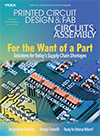Products
DX dispenser includes a mobile handheld dispenser with a refill station. Reportedly dispenses two component reactive resins at 1:1, 1.5:1, 2:1, 4:1, and 10:1 ratios. Multiple handheld dispensers can be quickly refilled with one DXR refill station. The refill station uses two transfer pumps that feed from 5-gal. bulk containers, each equipped with follower plates.
MIXPAC, www.mixpacequipment.com
MIXPAC, www.mixpacequipment.com
I&J7900-LF, an RoHS-compliant, compact three-axis dispensing robot, has a work area of 8 x 8" and a z-axis of 2".
Is said to be simple to program, with step-by-step point-and-click instructions. Resolution is said to be 20 mm. Up to 100 programs can be stored in the robot’s data memory or flash card. Can apply dots, lines, circles, and ellipses in any point-to-point or continuous path configuration.
I&J Fisnar, www.ijfisnar.com
Hysol FP5110 is specially formulated for flip-chip image sensor modules and is said to provide adhesion to both 2- and 3-layer flexible printed circuits by bonding to both polyimide and epoxy adhesive material.
Bonds bumps to substrates by means of a Pb-free-compatible thermal compression process. Compatible with thermal compression and ultrasonic bonding processes; low temperature 10-sec. SnapCure at 180°C; storage requirement of -15°C.
Bonds bumps to substrates by means of a Pb-free-compatible thermal compression process. Compatible with thermal compression and ultrasonic bonding processes; low temperature 10-sec. SnapCure at 180°C; storage requirement of -15°C.
Henkel, www.henkelelectronics.com
The MX high-speed component placement system is said to be capable of placement rates up to 80,000 cph. Features cascading modularity, with 216 feeder slots per segment; full-range component capability; double placement areas in each module, and a multilevel transport system reported to eliminate “local head-downtimes.”
Mimot, www.mimot.com
Mimot, www.mimot.com
The AST-700 bottom-side, screw-fastening work cell is designed to offer the ability to selectively fasten components using screws from the bottom side after odd-form placement. Uses a bowl-style system with blow feeder to automatically present and drive screws into the desired locations. Said to offer fully programmable x, y and z motion with in-line conveyor, positive PCB stop location/clamping, and programmable fastening locations. Includes a second chance feature with screw detection and purge function to prevent false error.
Promation, www.pro-mation-inc.com
IS415, a 200°C Tg product, is Pb-free compatible and offers improved signal integrity performance. Now has electrical loss in the 0.009 range using the split post resonant cavity method, and around 0.0135 using the Bereskin Stripline test method at 10 GHz. Currently available in North America, with manufacturing in Asia to begin in 2007. Is RoHS compliant and a UL94V-0-rated substrate.
Isola Group, www.isola-group.com
Isola Group, www.isola-group.com
Press Releases
- Altus Reports Growing Demand for Guidance on Convection Reflow Oven Specification
- Coherix Opens New Adhesive-Dispensing Vision Center in Europe
- Pan Pacific Strategic Electronics Symposium Program Finalized
- The Most Critical 2 Inches in SMT Manufacturing – When a Splice Fails, the Line Fails, Full Stop. Throughput and Yield Depend on One Overlooked Moment


